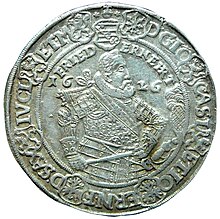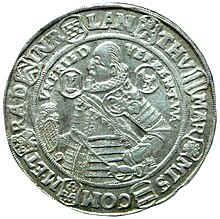Eintrachtstaler
Eintrachtstalers are thalers that are minted to commemorate a common and unanimous reign of several princes. Eintrachtstalers make sayings about unity.
Examples of Eintrachtstaler:
- 1533: Thaler from the brothers Bernhard and Ernst von Baden
- 1596–1633: Taler from the dukes Johann Casimir von Sachsen-Coburg and Johann Ernst von Sachsen-Eisenach
- Taler of the Dukes of Braunschweig-Lüneburg :
1599: Heinrich Julius with his three brothers Philipp Sigismund , Joachim Karl and Julius August
1617: Julius Ernst and August the Younger
1667: Rudolf August and Anton Ulrich
Eintrachtstaler 1626
The Duchy of Saxony-Coburg-Eisenach came into being after the Erfurt partition treaty of November 6th, 1572. It was transferred to the brothers Johann Casimir (born on June 12th 1564) and Johann Ernst (born on July 9th, 1566). From 1572 to 1596 the brothers were under the tutelage of Elector Friedrich III. von der Pfalz , Johann Georg von Brandenburg and August von Sachsen . From 1586 they ruled independently and together. In 1596 the brothers separated:
- Johann Casimir Duke of Saxe-Coburg with residence in Coburg
- Johann Ernst Duke of Saxe-Eisenach with residence in Gotha
After the death of childless Johann Casimir on July 16, 1633, both areas were reunited under Johann Ernst as the Duchy of Saxony-Coburg-Eisenach .
From 1577 joint coinage took place, which was continued even after their separation until 1633. Several Eintrachtstalers were minted during this time. The following Eintrachtstaler from 1626 contains the slogan separated on the front and back: "Peace nourishes - discord consumes".
- Johann Casimir Duke of Saxe-Coburg 1596–1633 and Johann Ernst Duke of Saxe-Eisenach 1596–1633
Reichstaler in accordance with the Augsburg Reich Decree of May 30, 1566 with 8 pieces from the Rauhen and 9 pieces from the Feine Mark
- Silver 14 Lot 4 Grän = 888.89 ‰
Fine weight: 25.984 g Rough weight target: 29.232 g Actual: 29.27 g - Diameter: 43.95-44.22 mm. Thickness: 2.42 mm
- Mint from 1623 to 1629 Saalfeld Mint
- Mint master: Wolf Albrecht the Younger in office 1612–1620 and 1623–1632
- Reversible embossing / smooth edge
- Obverse (obv.): Hip picture of Johann Casimir in flowered armor with bare head to the right, armband over the right shoulder, right hand holding regimental staff, left hand on the hip, next to it feathered helmet, sword in scabbard; The year is separated on both sides, with the beginning of the motto as an inner transcription in German: FRIED ERNEHRT
- Above, the imperial orb between two flowers, below the coat of arms of the Duchy of Saxony, eight coats of arms distributed between the outer and an inner circle (coat of arms of the duchies of Kleve, Jülich, Berg, Palatinate Counties of Saxony and Thuringia, County of Orlamünde, Margraviate of Meißen, Landgraviate of Thuringia), in between names of the minters and title DGIO / CASI / ET IO / ERNE / D.SAX / IV.CL / ET.M
- Reverse side (reverse): hip picture of Johann Ernst in armor with bare head to the left, field bandage, right hand on sword in scabbard, feathered helmet on the left, two coats of arms on both sides (Römhild reign on the left and Fürstete Grafschaft Henneberg on the right), above the continuation of the motto as inner inscription: VNFRIED VERZEHRT ◦ and in extension the first letter of the mint master: WA
- eight coats of arms distributed between the outer and an inner circle (coats of arms of Herrschaft Pleissen, Margraviate Landsberg, Burggrafschaft Altenburg, Herrschaft Eisenberg, Grafschaft Brehna, Regalienfeld, Grafschaft Ravensberg, Grafschaft Mark), in between continuation of the title LAN / THV / MAR / MIS / COM / M◦ET / RAD / IN◦R
- Title translation: DEI GRATIA JOHAN CASIMIR ET JOHAN ERNEST DUX SAXONIAE IVLIACI CLIVIAE ET MONTIUM // LANDGRAVII THURINGIÆ, MARCHIONES MISNENSES COMES MARC ET RAVENSPERG DNVS IN RAVENSTEIN (by the grace of God Johann Casimir and Johann Ernst Duke of Saxony) of Thuringia, Margrave of Meißen, Count of Mark and Ravensberg, Lord in Ravenstein)
From 1612, the Dukes are on the coins of the common coinage claim crest shown and corresponding title from the Jülich-Cleves succession dispute. These are the duchies of Kleve, Jülich and Berg and the counties of Mark and Ravensberg. On this Reichstaler, too, all coats of arms are depicted and the corresponding titles are listed in the inscription. The regimental staff indicates that Johann Casimir led a regiment on horseback in the Brunswick army in 1622.
Individual evidence
- ^ Friedrich von Schrötter: Dictionary of Coin Studies , 2nd edition 1970, p. 172

